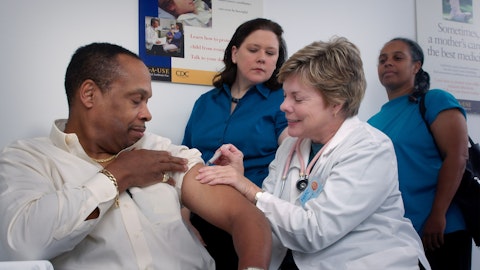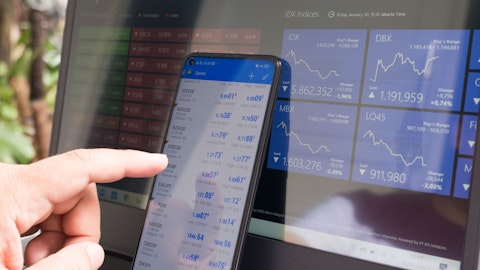Whitney Ijem: Hey guys, congrats on all the progress. First one from me is on COVID in Japan. I think you stand the benefit from orders there kind of on two fronts, both from a revenue sharing perspective as well as ARCALIS, so can you help us understand how those two will flow through your P&L or balance sheet when the orders and the manufacturing do start?
Joe Payne: So, yes, with respect to revenue sharing and any sort of additional financial elements due to the ARCALIS joint venture, Andy, do you want to address those?
Andy Sassine: Yes, certainly. Whitney, thanks for the question. We typically have not provided details with respect to the revenue-sharing opportunity. But if you look at the CSL and Arcturus 60/40 gross profit split, you can try to extrapolate what would a three-headed — or three musketeer type of partnership look like. So, it will obviously be very significant and meaningful for us, and we’re excited about the partnership to be working with all three people in Japan, especially Meiji they’re the number one flu vaccine company in Japan and CSL who’s number two in the world. So, you’re dealing with two very strong commercial powerhouses in their respective categories. So, we’re, kind of, fortunate with respect to that. And we’re pretty excited.
And of course, having it being made in Japan is kind of something that the government and the people in Japan are very proud of, and it’s going to be under the Meiji brand name. So, keep in mind that this is going to be a Japanese vaccine, and that’s what I think excites them. And the government — and we’re very fortunate that they gave us this opportunity to compare our vaccine to Pfizer, right? And if we didn’t have that opportunity, we would not have this kind of data to share with the world and the fact that they financially supported the factory. So, they bet on the right horse and I think it’s going to be an exciting future. And European approval is coming this year too. So, we’re highly excited about that, too. We’re anticipating it as well.
So, there’s a lot on the plate and hopefully, that gives you some perspective. But unfortunately, we can’t really go into too many details at this point in time. But hopefully, soon, we’ll be able to reveal those.
Operator: Our next question comes from Myles Minter with William Blair. Please proceed with your question.
Myles Minter: Hey, thanks for taking the questions. How important is it that the strain for your COVID vaccine actually gets adapted to XPP 1.5? I know you have in collaboration with CSL one in a Phase 3 immunogenicity trial, and I think there was some guidance that maybe we might hear about something in the first quarter. So, I just want to make sure that that’s on track? And is that also a gate or a gating factor for the first sale in Japan? Thanks.
Joe Payne: Well, yes, thanks for bringing those programs up. There’s a lot of — there’s a considerable amount of late-stage clinical data that’s being collected for this platform. You touched on a couple of these trials. One was the bivalent Phase 3 trial where we’re comparing bivalent Kostaive to bivalent Comirnaty, and that data is forthcoming soon. So, something that will help us be able to communicate how we perform in a multivalent or a bivalent setting to other technologies out there. With respect to the monovalent XBB trial, that one is designed to incorporate the Southern Hemisphere flu season cycle, and we’ll be able to share data for that program later this year as well. So you did ask whether these programs are prerequisite for certain regulatory discussions.
The answer is no for Japan and Europe, and we’ll find out for the United States, but we are collecting it in any case and CSL, our partners are funding these programs just to strengthen the data packages for each of these programs. And Pad, anything to add?
Pad Chivukula : Yes. Just — I’ll just add one other thing is that you might be aware, the current circulating strain that it seems to be JN.1. So ultimately, for the fall season, we will be — once the platform has been approved, we will update it and be ready to supply whatever circulating strain is needed.
Joe Payne: Correct. Yes. The WHO will be coming out with the updated variant announcement next month in April. Subsequent manufacturing runs and distribution will be forthcoming and message and guided through official press releases by Meiji.
Myles Minter: Okay. And then secondly, just on the CF program. I know you mentioned you’d be looking at respiratory function data from a safety perspective. I mean, would you obviously look at FEV1 from a safety perspective and then have to report that data anyway?
Joe Payne: For CF, yes, we’re collecting and — well, Pad, why don’t you address that?
Pad Chivukula : Yes. No, of course, we’re going to be collecting a lot of the safety signals, but then we’re going to be looking at FEV1 and lung clearance indexes as well. And — but we — again, just to reiterate, we are going to be recruiting relatively stable patients, there could potentially be no patients recruited in the population as well. But this is an all-comer study. So just so you’re aware.
Myles Minter: Helpful. Thanks very much.
Operator: Our next question is from Jan Hughes with Wells Fargo. Please proceed with your question.
Jan Hughes: Great. Thanks for taking our questions. I have a couple for Kostaive and a couple for the CF program. On Kostaive, I was wondering how many booster doses were distributed last year and purchased by the Japan government? And what percentage of that volume is for the three groups of people that you touched upon earlier on the call? And how would you expect that number to change this year?




